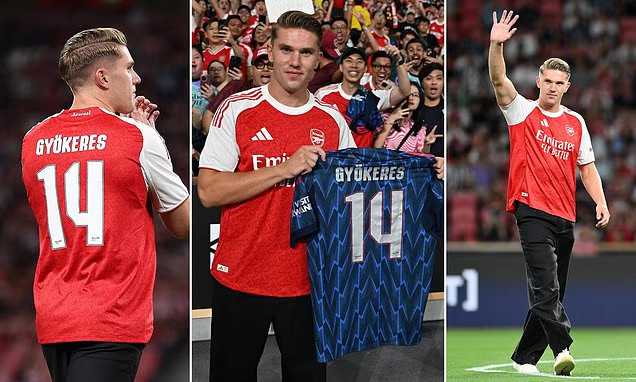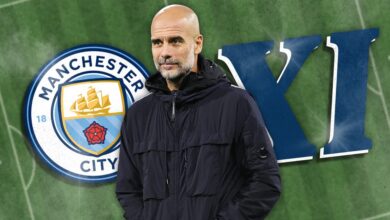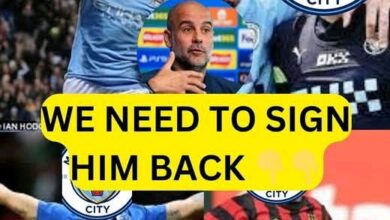The Gyokeres Effect: How Record-Breaking Shirt Sales Are Revolutionizing Football Transfers

The modern football transfer market has evolved far beyond simple player acquisitions. Today’s mega-deals represent complex intersections of sporting ambition, commercial strategy, and fan engagement that can make or break a club’s financial future. The recent phenomenon surrounding Viktor Gyokeres’ move to Arsenal serves as a compelling case study in how record-breaking shirt sales have become both a measure of transfer success and a driving force behind club decision-making.
In an era where football clubs operate as global brands competing for market share, the immediate commercial impact of a signing often matters as much as the player’s on-field contributions. The surge in merchandise sales following high-profile transfers has created a new metric for evaluating success – one that extends far beyond goals scored or trophies won.
Understanding record-breaking shirt sales requires delving into the psychological relationship between supporters and their clubs. When fans purchase a player’s jersey, they’re making a statement that transcends mere fashion. They’re investing emotionally and financially in the club’s vision, expressing optimism about the future, and literally wearing their loyalty.
The shirt becomes a tangible connection to hope. In Gyokeres’ case, Arsenal supporters hadn’t just been waiting for any striker – they’d been yearning for a player who could embody their championship aspirations. The Swedish forward’s prolific goal-scoring record at Sporting Lisbon, combined with his physical presence and clinical finishing, represented everything Arsenal fans believed their team needed.
This psychological investment explains why certain transfers generate unprecedented merchandise sales while others fail to capture public imagination. The player must represent more than individual talent; they must symbolize the club’s ambitions and supporters’ dreams. Gyokeres arrived at Arsenal carrying the weight of expectation that he could finally deliver the Premier League title that had eluded the club for nearly two decades
Record-breaking shirt sales represent a fascinating economic phenomenon where emotional investment directly translates into financial returns. Modern football clubs have become sophisticated in leveraging these emotional connections, understanding that the right signing can generate millions in immediate revenue while building long-term commercial value.
The financial mechanics behind these sales spikes reveal the true scale of modern football’s commercial engine. A typical Premier League club’s replica shirt retails for approximately £70-90, with the club receiving roughly 10-15% of that revenue after manufacturing costs, retailer margins, and licensing fees. However, when sales volumes explode following a marquee signing, the absolute revenue figures become substantial.
Conservative estimates suggest hat clubs can generate £15-25 million in additional merchandise revenue from a truly successful signing within the first year. This figure becomes even more impressive when considering international markets, where replica shirts often command premium prices and profit margins can be higher due to limited supply chains.
For Arsenal, Gyokeres’ shirt sales phenomenon represents validation of their transfer strategy from both sporting and commercial perspectives. The immediate revenue helps offset the significant transfer fee while demonstrating strong fan approval for the club’s direction.
The history of football transfers reveals several watershed moments where shirt sales reflected broader cultural shifts within the sport. Pelé’s arrival at New York Cosmos in 1975 generated unprecedented interest in soccer merchandise in North America, establishing a template for how marquee signings could transform clubs’ commercial prospects.
More recently, Cristiano Ronaldo’s return to Manchester United in 2021 shattered previous records, with the club reportedly recouping a significant portion of his transfer fee through shirt sales alone within weeks of the announcement. The Portuguese superstar’s global appeal, combined with nostalgic connection to United’s successful era, created perfect conditions for commercial explosion.
Similarly, Lionel Messi’s shock move to Paris Saint-Germain generated extraordinary merchandise sales across multiple continents, with fans eager to own a piece of football history. The Argentine’s PSG shirts became collector’s items almost immediately, with some limited editions selling for hundreds of pounds above retail price.
These historical precedents established shirt sales as both a barometer of fan excitement and a crucial revenue stream that could justify enormous transfer expenditures. Clubs began factoring potential merchandise sales into their transfer calculations, recognizing that the right player could deliver immediate returns while building long-term brand value.
To understand the Gyokeres phenomenon fully, one must appreciate Arsenal’s specific context and their supporters’ particular hunger for success. The Gunners haven’t won the Premier League since 2004, despite consistent Champions League qualification and several near-misses in recent seasons. This prolonged title drought created intense pressure on the club to make statement signings that could bridge the gap to Manchester City and other elite rivals.
Arsenal’s transfer strategy in recent years had focused on young, promising players who could develop into world-class talents. While this approach yielded success with players like Bukayo Saka and Gabriel Martinelli, it left supporters craving an established goalscorer who could deliver immediate impact. The club’s struggles to convert chances into goals had become a recurring theme, with fans frequently debating whether Arsenal lacked the clinical edge necessary for title contention.
Gyokeres represented the antithesis of Arsenal’s usual transfer profile – an established, proven goalscorer entering his prime years with a track record of consistent performance at the highest level. His 97 goals in 102 appearances for Sporting Lisbon wasn’t just impressive statistically; it demonstrated the kind of ruthless efficiency Arsenal supporters believed their team desperately needed.
The Swedish striker’s arrival also carried symbolic weight beyond his individual qualities. His willingness to wear the iconic number 14 shirt previously worn by Thierry Henry created an immediate emotional connection with Arsenal’s golden era. Henry remains the club’s greatest modern player, and his number had remained largely untouched since his departure, making Gyokeres’ decision particularly meaningful for supporters.
Modern record-breaking shirt sales occur within a dramatically different commercial landscape than previous generations. Social media amplifies transfer announcements exponentially, creating global conversations that drive immediate purchasing decisions. Arsenal’s announcement video for Gyokeres generated millions of views within hours, translating into immediate website traffic and sales inquiries.
The club’s digital strategy around the transfer reveal demonstrated sophisticated understanding of modern fan engagement. Rather than simply announcing the signing, Arsenal created narrative tension through carefully orchestrated social media campaigns, behind-the-scenes content, and interactive fan experiences. This approach maximized emotional investment before the sales window even opened.
E-commerce capabilities have also revolutionized how clubs capitalize on transfer excitement. Arsenal’s website infrastructure can handle massive traffic spikes, process thousands of simultaneous orders, and deliver personalized shopping experiences that encourage additional purchases beyond basic replica shirts. The club’s decision to offer free name and number printing created artificial urgency that drove immediate sales while building goodwill with supporters.
International shipping capabilities mean that record-breaking sales now span multiple continents simultaneously. Arsenal’s global fanbase, built through decades of Premier League success and strategic marketing, provided enormous potential market for Gyokeres merchandise. The club’s partnerships with regional retailers and distributors ensured availability across major markets, preventing supply shortages that might limit sales potential.
The significance of Gyokeres choosing Arsenal’s number 14 shirt cannot be overstated in understanding the commercial and emotional impact of his arrival. Thierry Henry’s legacy at Arsenal transcends individual achievements, representing the club’s most successful era and embodying everything supporters hope to recapture.
Henry’s 228 goals in 377 appearances established him as Arsenal’s greatest modern player, but his impact extended far beyond statistics. The Frenchman’s style, personality, and crucial goals in defining moments created emotional connections that endure decades after his departure. His number 14 shirt became synonymous with Arsenal excellence, making any successor’s decision to wear it particularly meaningful.
For Gyokeres, accepting the number 14 demonstrated confidence in his ability to handle enormous expectations while honoring Arsenal’s history. This decision resonated powerfully with supporters who viewed it as evidence of his commitment to the club’s championship ambitions. The symbolic weight of Henry’s number added layers of meaning to every Gyokeres shirt purchase, transforming routine merchandise transactions into statements of faith in Arsenal’s future.
The commercial implications were immediate and substantial. Arsenal’s marketing team recognized the narrative power of the Henry connection, featuring it prominently in announcement materials and promotional campaigns. The “legacy continues” messaging created emotional urgency that drove purchasing decisions while positioning Gyokeres as Arsenal’s next iconic striker.
Record-breaking shirt sales in modern football reflect increasingly global fan bases and sophisticated international marketing strategies. Arsenal’s commercial success with Gyokeres merchandise demonstrates how Premier League clubs have become worldwide brands with supporters spanning every continent.
The timing of Gyokeres’ announcement during Arsenal’s pre-season tour of Asia proved strategically brilliant, allowing the club to capitalize on regional excitement while building local media coverage. Asian markets represent enormous growth opportunities for Premier League clubs, with supporters often demonstrating remarkable loyalty and purchasing power despite geographical distance from London.
Currency fluctuations, shipping costs, and regional pricing strategies all influence international shirt sales patterns. Arsenal’s partnership with regional distributors ensures competitive pricing while maintaining quality standards, crucial factors in driving volume sales across diverse markets. The club’s understanding of local preferences – such as preferred payment methods, sizing variations, and delivery expectations – maximizes conversion rates from interest to actual purchases.
Social media’s global reach means that transfer announcements generate simultaneous excitement across time zones, creating worldwide sales spikes that dwarf previous generations’ purely local phenomena. Arsenal’s multilingual social media strategy ensures that Gyokeres’ announcement reached supporters in their native languages, maximizing engagement and subsequent purchasing behavior.
Record-breaking shirt sales create enormous logistical challenges that clubs must navigate carefully to avoid disappointing supporters. The lead times required for mass production mean that clubs often must forecast demand before transfers are even confirmed, risking significant financial losses if deals fall through or fail to generate expected interest.
Arsenal’s preparation for Gyokeres’ arrival demonstrated sophisticated supply chain management and demand forecasting. The club’s partnership with Adidas ensured sufficient manufacturing capacity to handle surge demand while maintaining quality standards. However, even with careful planning, the scale of interest caught many by surprise, leading to temporary stock shortages that actually increased demand through scarcity psychology.
The decision to offer free name and number printing created additional operational complexity, requiring expanded personalization facilities and extended processing times. However, this promotional strategy proved commercially brilliant, encouraging immediate purchases while building positive brand associations that could drive future sales.
Quality control becomes particularly crucial during high-volume production periods, as any defects or inconsistencies can damage brand reputation precisely when clubs are receiving maximum attention. Arsenal’s insistence on maintaining standard quality levels despite rushed production schedules demonstrated long-term thinking that protects brand value beyond immediate sales figures.
Football shirts represent far more than clothing in modern fan culture – they’re identity markers that communicate loyalty, optimism, and belonging. The record-breaking sales surrounding Gyokeres’ arrival reflect deeper currents in how supporters express their connection to clubs and participate in shared narratives of hope and ambition.
Wearing a new signing’s shirt becomes a form of social signaling within fan communities, indicating early adoption of the club’s new direction and confidence in leadership decisions. Arsenal supporters purchasing Gyokeres shirts weren’t just buying merchandise; they were joining a collective statement of belief in the club’s championship prospects.
The phenomenon also reflects changing generational attitudes toward football consumption. Younger supporters, raised in the digital age, often view shirt purchases as investments in social media content and personal brand building. Instagram posts featuring new shirts generate social validation while demonstrating fan credentials within online communities.
Regional variations in fan culture influence purchasing patterns significantly. London-based Arsenal supporters might prioritize wearing shirts to matches, while international fans often purchase multiple versions for different occasions. Understanding these cultural nuances allows clubs to develop targeted marketing strategies that maximize sales across diverse supporter bases.
Record-breaking shirt sales create ripple effects throughout football’s commercial ecosystem that extend far beyond individual clubs. Sporting goods retailers experience surge demand that can strain inventory systems and staffing levels, while manufacturers must rapidly adjust production schedules to capitalize on unexpected opportunities.
The success of Gyokeres’ shirt sales likely influences other clubs’ transfer strategies, demonstrating how commercial considerations increasingly factor into player recruitment decisions. Clubs may prioritize signings with strong personal brands and social media followings, recognizing that marketing appeal can generate revenues that justify higher transfer fees.
Secondary markets also benefit from record-breaking sales phenomena, with limited edition or sold-out versions often commanding premium prices among collectors. Some Arsenal supporters unable to secure official Gyokeres shirts may turn to alternative retailers or vintage options, creating broader economic activity around the transfer.
The media attention generated by exceptional sales figures creates additional value through earned coverage that would cost millions if purchased as advertising. Arsenal’s record-breaking Gyokeres sales became news stories themselves, generating global coverage that reinforced the club’s brand strength and transfer success.
From a purely financial perspective, record-breaking shirt sales represent immediate return on transfer investments that can significantly impact clubs’ profit and loss calculations. While the exact figures remain commercially sensitive, industry estimates suggest that successful signings can generate £20-30 million in additional merchandise revenue within their first year.
These revenues become particularly valuable given their timing and character. Unlike prize money or broadcast revenues that arrive according to predetermined schedules, merchandise sales provide immediate cash flow that can help clubs manage transfer payment structures and maintain financial flexibility.
The profit margins on official merchandise typically exceed those of most other club revenue streams, making shirt sales particularly attractive from an accounting perspective. When clubs can generate millions in high-margin revenue directly from transfer announcements, it transforms the economics of player recruitment and creates incentives for increasingly ambitious signings. However, clubs must balance short-term merchandise gains against long-term brand value and sporting success. Record-br















